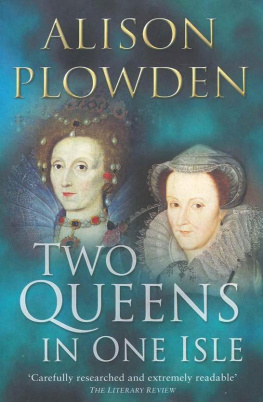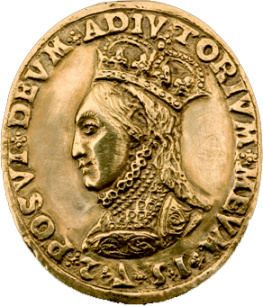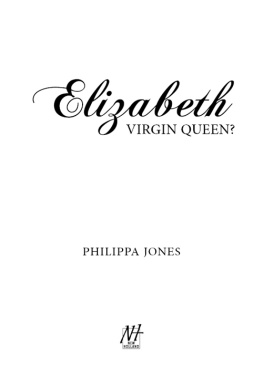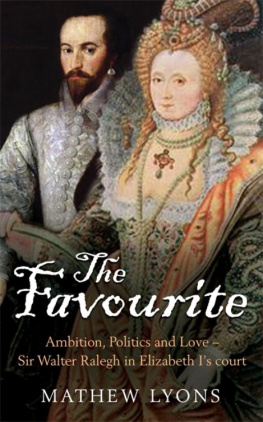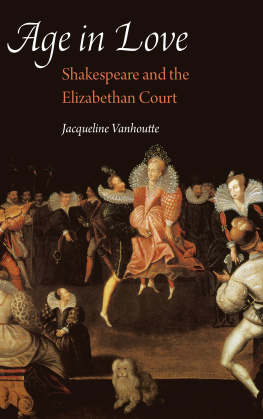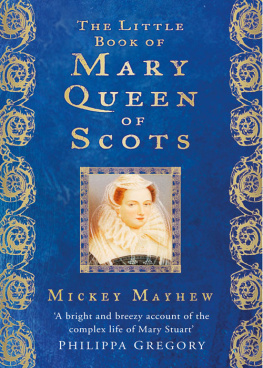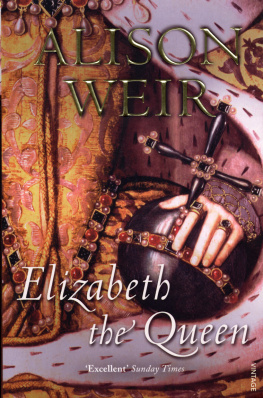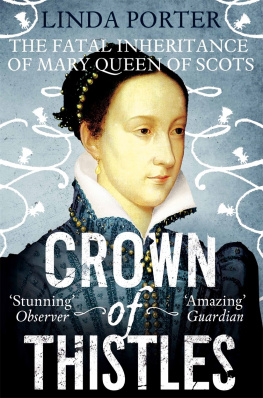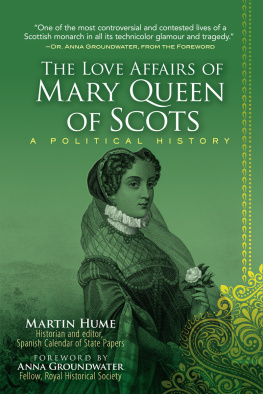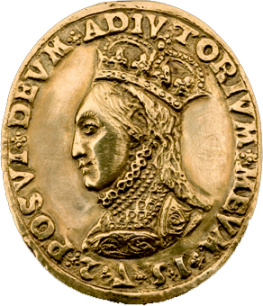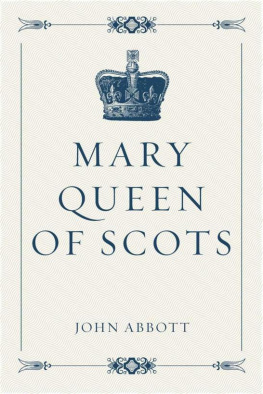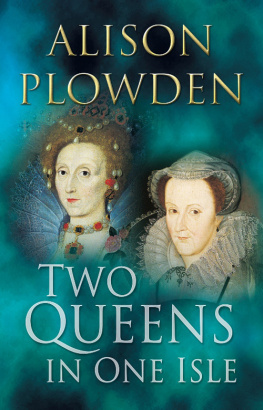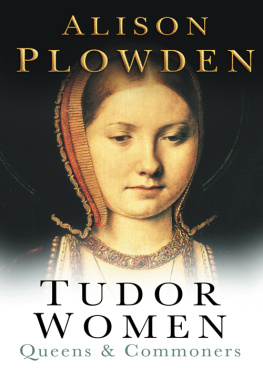
Nothing should be left undoneto perfect the amity betwixt thetwo Queens in one isle.
Francis, Duke of Guise
The author would like to thank Dr Bruce Lenman of the Department of Modern History, University of St Andrews for his help in suggesting sources for this book, and also Sir A. Goldberg, Regius Professor of Medicine, University of Glasgow for his kindness in sparing the time to discuss the question of Mary Queen of Scots and porphyria.
Contents

O n Thursday, 28 April 1603 the royal suburb of Westminster was packed solid with multitudes of all sorts of people crowding the streets, leaning out of windows, standing on rooftops and gutters, clinging precariously to every point of vantage to watch the passing of a great funeral procession. The citizens of Londonor as many as could squeeze themselves into the limited space availablehad come to say goodbye to the Queen who had been reigning over England for longer than the vast majority of those present that April day could remember.
More than a thousand men and women, all in black mourning hoods and cloaks, from the humblest servants of the royal scullery and woodyard to the great officers of State, the trumpeters and sergeants-at-arms, the heralds and pursuivants, the Gentlemen and Children of the Chapel Royal, the Lord Mayor and Aldermen of the City, the judges and principal law officers of the crown, the Gentlemen Pensioners, the foreign ambassadors, Privy Councillors and lords and ladies of the Court, marched in solemn order from the Palace of Westminster to the nearby Abbey Church of St Peter to do honour to Queen Elizabeth of famous memory in an impressive display of funereal pomp and pageantry. When the purple draped coffin came in sight, drawn on an open chariot by four black trapped horses and surmounted by a lifesize waxen effigy of the Queen, dressed in her Parliament robes, with a crown on her head and a sceptre in her hand, a great sigh went up from the spectators, and such a general groaning and weeping as the like hath not been seen or known in the memory of man. Neither, wrote John Stow, doth any history mention any people, time or state, to make like lamentation for the death of their sovereign. They laid Elizabeth Tudor to rest in the Abbey, in the north aisle of the chapel built by King Henry VII, her grandfather, and the officers of the household ceremonially broke their staves and cast them into the open grave.
A little over nine years later, in October 1612, another royal coffin was carried in procession through the London streets, when the corpse of Queen Mary, late Queen of Scotland, was translated from Peterborough unto St Peters Church in Westminster. The cortege was met at Clerkenwell, at about six oclock on the evening of Thursday, 8 October by a deputation headed by the Archbishop of Canterbury, the Lord Chancellor and the Lord Privy Seal and escorted to Westminster, with plenty of torchlights flaring in the autumn dusk. It does not appear to have attracted much public interest.
Later that same night the body of Mary Stewart, once Queen of Scotland and Queen Dowager of France, was re-buried on the south side of the Henry VII Chapel, to be closer at last in death to her cousin Elizabeth than she ever came in life. And there they lie, those two sister queens and tender cousins, beneath the handsome monuments piously erected by Marys son, James I and VI, in the chapel of their common ancestor, the first Tudor kingall the bitterness and tragedy, all the passions roused by their deadly rivalry transmuted by time into dust and marble.
I t all began with a peace treaty and a marriage: on 24 January 1502, to be exact, when the English royal family gathered at Richmond Palace to witness the solemn betrothal of Henry VIIs eldest daughter Margaret to James IV of Scotland. The King and Queen were accompanied by two of their other children, ten-year-old Henry and six-year-old Mary, and by the Queens sister Katherine Courtenay. Also present, as befitted so important an occasion, were the Archbishops of Canterbury and York, the Spanish and Venetian ambassadors with their suites, and likewise the members of the Privy Council and a great number of the nobles of England together with their ladies. The Scottish delegation was headed by the Archbishop of Glasgow and Patrick Hepburn, Earl of Bothwell, the bridegrooms procurator or proxy.
After attending High Mass and listening to an eloquent sermon preached by the Bishop of Chichester, the whole illustrious company crowded into the Queens Great Chamber for the betrothal ceremony itself. According to established practice, the Archbishop of Glasgow began by asking all the parties to the marriage contract whether they knew of any impediments or objections. King Henry, speaking for his daughter, then asked whether it was indeed the very will, mind and full intent of the King of Scotland that the Earl of Bothwell should, in his name, assure the princess.
Satisfactory answers having been given to all these questions, the Archbishop turned to Margaret herself to enquire if she was content of her own free will, and without compulsion to wed his master, and received the very proper reply: If it pleases my lord and father the King, and my lady and mother the Queen, I am content. The twelve-year-old bride knelt for her parents blessing and it was time to exchange the vows.
The Earl of Bothwell repeated that he had been given sufficient power and authority to contract matrimony per verba de presenti on behalf of his sovereign lord, and solemnly plighted King Jamess faith and troth. Now it was the princesss turn. Standing handfasted with Bothwell, a resplendent figure in cloth of gold, she spoke her piece with perfect self-possession: I, Margaret, first begotten daughter of the right excellent, right high and mighty Prince and Princess, Henry, by the grace of God King of England, and Elizabeth, Queen of the same, wittingly and of deliberate mind, having twelve years complete in age in the month of November last past, contract matrimony with the right excellent, right high and mighty Prince James, King of Scotland and take the said James, King of Scotland, unto and for my husband and spouse, and all other forsake during his and mine lives natural; and thereto I plight and give to him my faith and troth.
The royal trumpeters, concealed in the rafters of the Great Chamber, sounded a fanfare and the musicians struck up in their best and most joyfullest manner. Although the marriage still had to be sanctified by the Church and it had been agreed that the bride should remain with her parents for another eighteen months, betrothal per verba de presenti that is, with the promises made in the present tenserepresented a legally binding contract, and at the banquet which followed young Margaret took equal precedence with her mother as a married woman and a queen. The festivities went on for three days, with tournaments, disguisings, morris dancing and more banquets. Bonfires were lit in the streets of London, the church bells rang out, a solemn Te Deum was sung at St Pauls Cathedral and twelve hogsheads of free wine were provided for the citizens.
The elaborate celebrations which marked Princess Margaret Tudors fiancels the lavish indigestible meals, the pageantry, the jousting and dancing and public rejoicingalso marked the successful culmination of nearly seven years of patient diplomacy, during which her father had striven to secure a lasting peace with his next-door neighbours. For centuries Anglo-Scottish relations had been at worst actively hostile, at best in a state of uneasy truce, and a treaty which would safeguard Englands vulnerable northern frontier, loosen Scotlands longstanding French connections, as well as putting an end to the perennial nuisance of cross-Border raiding and cattle-stealing, must be a valuable diplomatic achievement. All the same, in spite of the obvious advantages gained by this conversion of the Truce of Ayton into a perpetual peace, and the fact that it was common practice to seal such an alliance with a royal marriage, some of King Henrys councillors had had their reservations.
Next page
